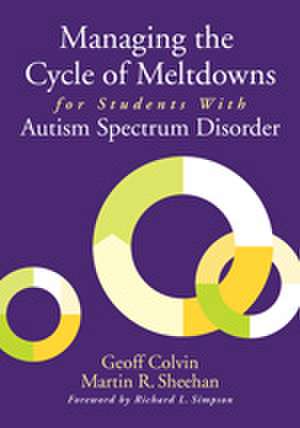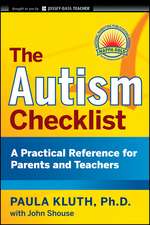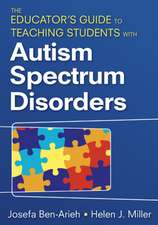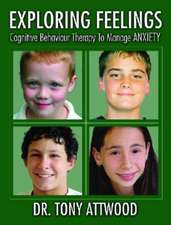Managing the Cycle of Meltdowns for Students With Autism Spectrum Disorder
Autor Geoffrey T. Colvin, Martin R. Sheehanen Paperback – 10 iul 2012
Preț: 285.50 lei
Nou
Puncte Express: 428
Preț estimativ în valută:
54.64€ • 56.72$ • 45.56£
54.64€ • 56.72$ • 45.56£
Carte tipărită la comandă
Livrare economică 22 martie-05 aprilie
Preluare comenzi: 021 569.72.76
Specificații
ISBN-13: 9781412994033
ISBN-10: 1412994039
Pagini: 240
Dimensiuni: 178 x 254 x 18 mm
Greutate: 0.48 kg
Ediția:1
Editura: SAGE Publications
Colecția Corwin
Locul publicării:Thousand Oaks, United States
ISBN-10: 1412994039
Pagini: 240
Dimensiuni: 178 x 254 x 18 mm
Greutate: 0.48 kg
Ediția:1
Editura: SAGE Publications
Colecția Corwin
Locul publicării:Thousand Oaks, United States
Recenzii
"This book provides educators and parents with current research-based strategies for helping to recognize the stages of meltdown in children with ASD and a model for systematic analysis and action. The strategies suggested are comprehensive and sensitive to the diversity of student needs."
"This how-to book provides a good introduction to the meltdown cycle and strategies anyone can implement. I recommend it as a particularly good resource for administrators and others who have had limited experience with autism."
"This text meets a need for special educators who work with ASD students. The material is useful and easy to navigate. The appendices offered some very concrete examples that are helpful for implementation."
"The author clearly explains the process of meltdown prevention and includes tables, lists and charts that summarize important points in the text. These features help teachers encapsulate the information into manageable, memorable bites, and are helpful for analyzing real-life situations."
“An indispensable resource for teachers working with students with ASD, this book is informative, useful, easy to follow, and loaded with wisdom on analyzing challenging meltdown behaviors, identifying triggers, and implementing effective interventions.”
“As parents of a teenage boy with Autism, we highly recommend this book. Although our son has not had a true meltdown in many years, he still periodically displays the rest of the cycle. We learned from Geoff and Martin’s book that what we once regarded as problem behaviors are really very purposeful strategies for achieving his various goals. We wish we'd had this resource 15 years ago! However, we are now better equipped to manage his current needs.”
"This book is a key to keeping autistic meltdowns from taking over a classroom. Practical steps to recognizing, preventing and responding to common phases of meltdown behaviors with autism spectrum disorder students provides a guide that advocates positive behavior support and gives basic keys to achieving these goals."
"This how-to book provides a good introduction to the meltdown cycle and strategies anyone can implement. I recommend it as a particularly good resource for administrators and others who have had limited experience with autism."
"This text meets a need for special educators who work with ASD students. The material is useful and easy to navigate. The appendices offered some very concrete examples that are helpful for implementation."
"The author clearly explains the process of meltdown prevention and includes tables, lists and charts that summarize important points in the text. These features help teachers encapsulate the information into manageable, memorable bites, and are helpful for analyzing real-life situations."
“An indispensable resource for teachers working with students with ASD, this book is informative, useful, easy to follow, and loaded with wisdom on analyzing challenging meltdown behaviors, identifying triggers, and implementing effective interventions.”
“As parents of a teenage boy with Autism, we highly recommend this book. Although our son has not had a true meltdown in many years, he still periodically displays the rest of the cycle. We learned from Geoff and Martin’s book that what we once regarded as problem behaviors are really very purposeful strategies for achieving his various goals. We wish we'd had this resource 15 years ago! However, we are now better equipped to manage his current needs.”
"This book is a key to keeping autistic meltdowns from taking over a classroom. Practical steps to recognizing, preventing and responding to common phases of meltdown behaviors with autism spectrum disorder students provides a guide that advocates positive behavior support and gives basic keys to achieving these goals."
Cuprins
Foreword by Richard L. Simpson
Acknowledgments
About the Authors
Introduction
Section I: A Model for Meltdown Behavior of Students With ASD
1. Autism Spectrum Disorder, Overview
2. The Nature of Meltdowns
3. A Six-Phase Model of the Meltdown Cycle
Section II: Strategies for Managing the Phases of the Meltdown Cycle
4. Calm Phase
5. Trigger Phase
6. Agitation Phase
7. Meltdown Phase
8. Re-Grouping Phase
9. Starting-Over Phase
10. The Parent Component
Closing Remarks
Appendices
References
Index
Acknowledgments
About the Authors
Introduction
Section I: A Model for Meltdown Behavior of Students With ASD
1. Autism Spectrum Disorder, Overview
2. The Nature of Meltdowns
3. A Six-Phase Model of the Meltdown Cycle
Section II: Strategies for Managing the Phases of the Meltdown Cycle
4. Calm Phase
5. Trigger Phase
6. Agitation Phase
7. Meltdown Phase
8. Re-Grouping Phase
9. Starting-Over Phase
10. The Parent Component
Closing Remarks
Appendices
References
Index
Notă biografică
Descriere
This book's seven-phase model, which is similar to positive behavior support, helps teachers pinpoint specific behaviors, develop interventions at each phase, and create an individualized behavior support plan.













